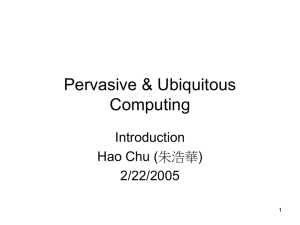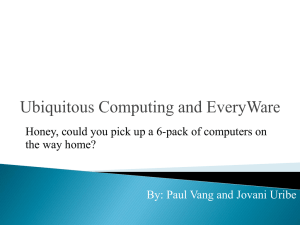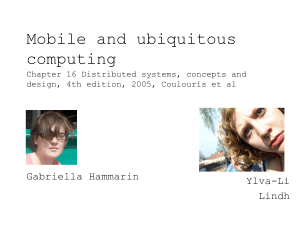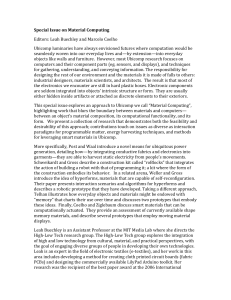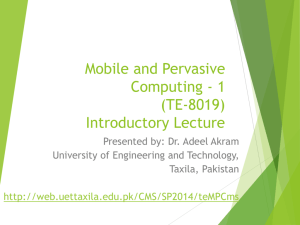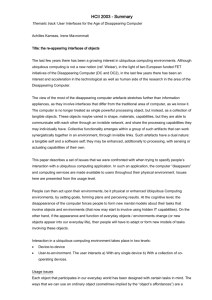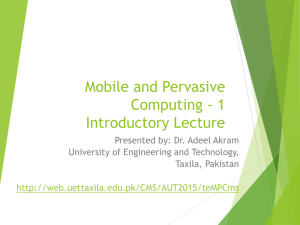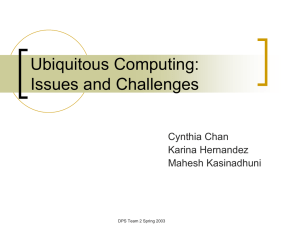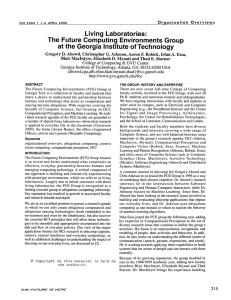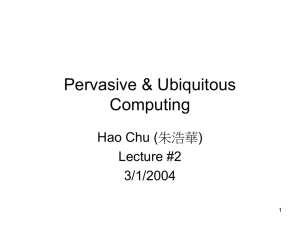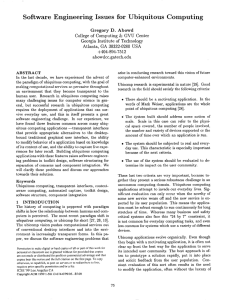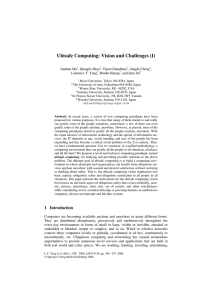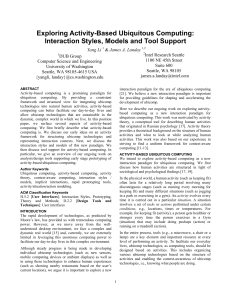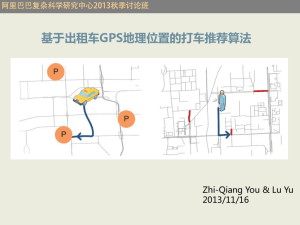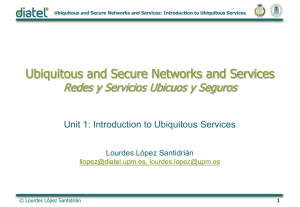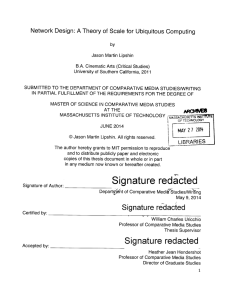White paper
advertisement
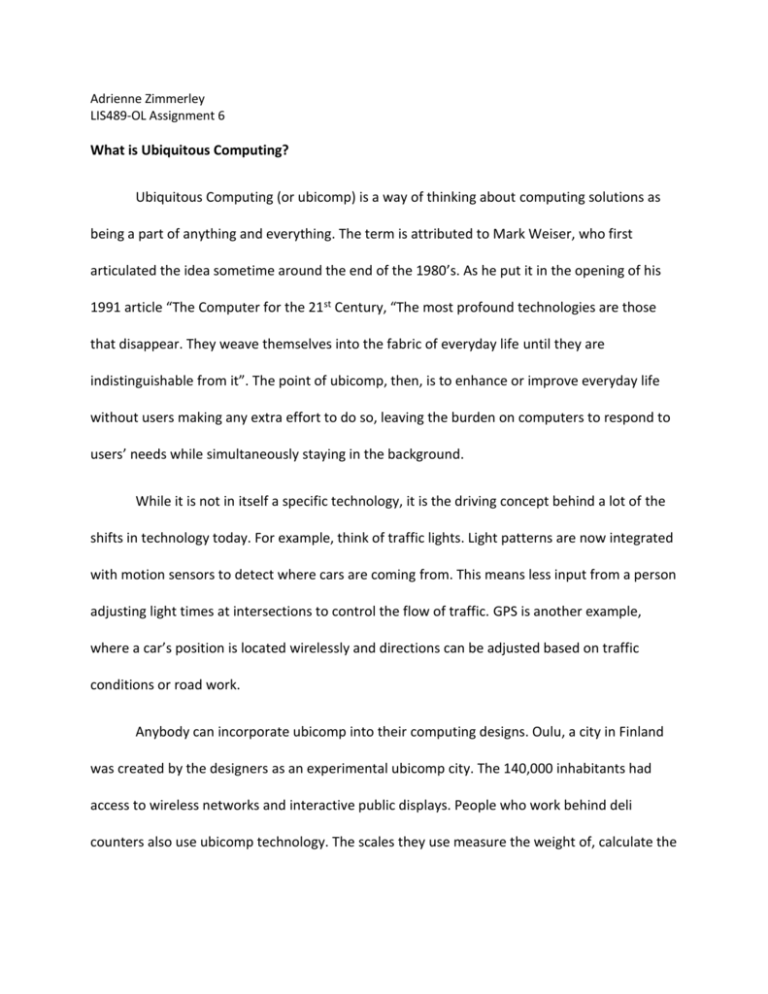
Adrienne Zimmerley LIS489-OL Assignment 6 What is Ubiquitous Computing? Ubiquitous Computing (or ubicomp) is a way of thinking about computing solutions as being a part of anything and everything. The term is attributed to Mark Weiser, who first articulated the idea sometime around the end of the 1980’s. As he put it in the opening of his 1991 article “The Computer for the 21st Century, “The most profound technologies are those that disappear. They weave themselves into the fabric of everyday life until they are indistinguishable from it”. The point of ubicomp, then, is to enhance or improve everyday life without users making any extra effort to do so, leaving the burden on computers to respond to users’ needs while simultaneously staying in the background. While it is not in itself a specific technology, it is the driving concept behind a lot of the shifts in technology today. For example, think of traffic lights. Light patterns are now integrated with motion sensors to detect where cars are coming from. This means less input from a person adjusting light times at intersections to control the flow of traffic. GPS is another example, where a car’s position is located wirelessly and directions can be adjusted based on traffic conditions or road work. Anybody can incorporate ubicomp into their computing designs. Oulu, a city in Finland was created by the designers as an experimental ubicomp city. The 140,000 inhabitants had access to wireless networks and interactive public displays. People who work behind deli counters also use ubicomp technology. The scales they use measure the weight of, calculate the cost of, and print the label for the meat or cheese they slice for a customer. To some extent, every profession uses ubicomp software in some way. What are the benefits? The goal of ubiquitous computing is to make everyday tasks simpler and easier to manage. This isn’t intended to totally negate the need for user input or interaction, but to make it less demanding and to shift the focus away from the computer. Users who have to do less to get to information are more likely to use that technology, until it becomes second nature. Ubiquitous computing is also gaining support, as evidenced by some of the technological advances available today. Smart phones are a form of ubiquitous computing, and are almost used universally on a global scale to address a variety of needs. Cameras, alarm clocks, video recorders, calendars, the internet and several other applications can be accessed using one small computer that was originally designed to be just a mobile version of a telephone. This has led many to argue that we already live in an ubicomp world. The beauty of ubiquitous computing is that it can address multiple needs at one time. The concept pushes the boundaries of imagination and dynamic solutions. Users with very different needs can utilize the same technology and to accomplish their tasks. Again, the smart phone is good example of this. Three people, one needing a high quality camera, the second needing to access the internet, and the third needing to listen to music can all use the same model of smart phone to address their needs. What are the negative aspects? Ubiquitous computing is a complex concept. While it is seemingly useful for any discipline or profession, its dynamism can lead to incompatible designs. Technologies that try to meet the needs of multiple people or professions can end up being so complicated that accommodating everyone’s requirements may lead to overly involved, not-user-friendly interfaces. There is no one consensus on what constitutes ubiquitous computing. Some think we are already there, with tablets, phones and laptops changing the way websites are created. Others think of ubiquitous computing as pervasive computing – the kind that exists without any direct input from users. Still others think it is a mixture of the two. While this is positive in one sense, creating a diverse field, it makes standardization difficult if not impossible. For professionals outside of computer science it can be difficult to try to visualize ubicomp solutions when they can’t fully understand what is meant by the term. Technology based on the concept of the ubiquitous computing can be very expensive. A large number of applications are new enough that they are still considered proprietary. Customization of technologies can also be costly, with even small changes requiring a significant amount of money. Even though people are becoming less aware of how commonplace computers are, the idea of actively letting computers control everything is still unnerving and frightening to a lot of people. I only need to listen to some of my fellow classmates to hear that there is pushback on using computers to do everything. Archivists and archive advocates, too, have a tendency to use the tactile nature of print materials as a selling point for the profession. If computers replace some of the mundane tasks of using an archives, archivists will have to re-think how they present themselves and their value to others. Why should archivists integrate ubiquitous computing into their practices? Archivists have many challenges before them with new technology. Between digitizing records, preserving born digital records, and making collections accessible the profession has approached these issues by using pre-made technology and adapt our practices to fit it. Sometimes traditional archival processes complement those in computer and information science (for example, using RDBMS instead of card catalogs). This has proven to have mixed, non-standardized results. Some repositories implement these new technologies well, others less so. In every case, however, archivists have had to prioritize some needs over others. Looking at ubicomp, however, we can blend our information management needs with the access needs of our users in a much more dynamic manner. Imagine a wall that could display to patrons the metadata of any painting that was hung on it, allowing them to comment on it or “like” it (as on Facebook). At the same time, using sensors, it would allow staff members (wearing badges) to see any preservation issues detected, how long the painting has been on display, and track what patrons think of the paintings. Ubiquitous computing is only limited by our imagination. Incorporating the concept into how we envision using technology to answer our needs and our users’ needs will benefit our profession overall. It will give us more control over our information management, and simplify and enhance our everyday tasks, until we don’t even notice that we are using computers to get things done.



